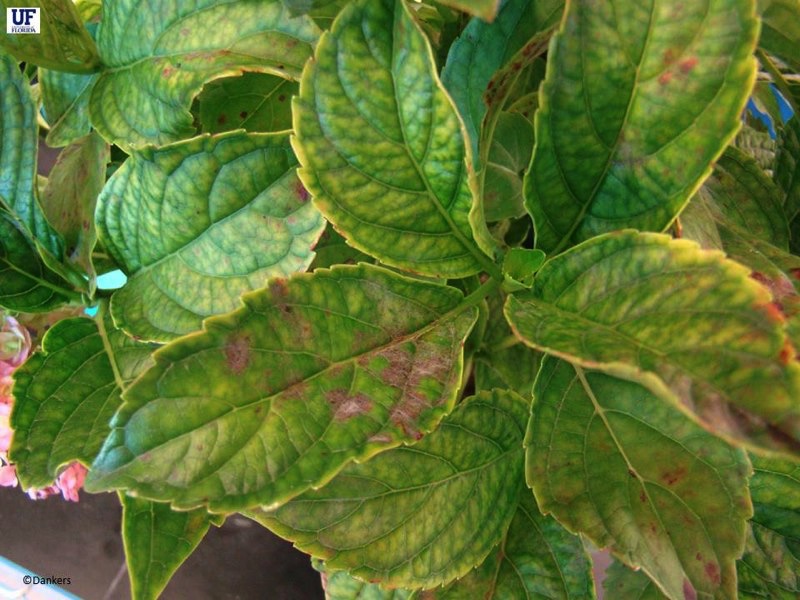Not known Details About Hydrangea Leaves Turning Yellow
Wiki Article
The Facts About Hydrangea Leaves Turning Yellow Revealed
Table of ContentsThe Basic Principles Of Hydrangea Leaves Turning Yellow Some Ideas on Hydrangea Leaves Turning Yellow You Need To KnowThe smart Trick of Hydrangea Leaves Turning Yellow That Nobody is Discussing3 Easy Facts About Hydrangea Leaves Turning Yellow ShownThe Hydrangea Leaves Turning Yellow PDFs
As you seen in the section above this can be triggered by underwatering. Overwatering can also trigger dehydration, as counterproductive and unusual as that may appear. Overwatering can choke off oxygen to the roots, which your houseplant needs to make it through. The moist water-soaked dirt will certainly likewise imply plant roots will start to pass away as root rot takes hold.Thus the plant ends up being dehydrated despite the fact that it is sitting in a wealth of water. Rotting origins will turn glossy and black with a mushy texture and a rotting smell. The fallen leaves of your hydrangea may diminish, and the ones that are still attached will be yellowed or brownish and be mushy at the stem.
Without your treatment, those fallen leaves will quickly turn brown, then black as they burn. Where you put your hydrangea matters a great deal if you desire your plants to maintain its full deepness of color and have appealingly environment-friendly fallen leaves. SIf your hydrangea is an interior plant in your house then you will likely have a choice of four window instructions: north, south, eastern, and west.
The Facts About Hydrangea Leaves Turning Yellow Uncovered
Hydrangea getting good light, Straight sunlight for hydrangeas is appropriate in the morning. Straight light is the kind of light a plant gets when it rests directly in the sun.Dappled color indicates your hydrangeas have above cover, such as a larger tree or plant. The sun comes via directly, but the cover of the bigger plant enables the sunlight in only occasionally via the openings in the branches or leaves. Hydrangeas can grow in direct sun as long as they are well watered a watered frequently.
Photosynthesis, as we all understand, is important for plant survival, so chlorosis requirements to be dealt with promptly. Hydrangea Leaves Turning Yellow. While chlorosis can be brought on by other nutrient deficiencies, it is most generally an iron deficiency. In the adhering to section you will learn how to recognise whether your plant has an iron deficiency or something else
likewise initially appears on the older fallen leaves, however the leaf blood vessels remain green. A magnesium shortage shows up first on old fallen leaves and should not be confused with an iron deficiency [Image: izzzy71/ Shutterstock. com] While there is usually sufficient iron in natural dirt, hydrangeas often battle to absorb sufficient of it.
The Basic Principles Of Hydrangea Leaves Turning Yellow
The best method see this here to avoid iron deficiency-chlorosis in hydrangeas is to plant them in suitable ericaceous or acidic dirt. When planting in a bed, mix in some peat or reduced-peat ericaceous compost and check the p, H value once a year. This is needed due to the fact that the garden compost blend around the plants will certainly affect the p, H value of the soil in the lengthy run and the p, H worth might rise once more.It is just used on a commercial scale, where a prolonged iron shortage would indicate considerable yield losses. The special fertilisers for this are typically expensive and need to be applied in extremely accurate doses to avoid damages to the fallen leaves. Foliar fertilisation is just efficient for a short duration and must be used regularly or supplemented by typical iron fertilisation.
Input your search key phrases and press Enter.
We're best in the center of our late-blooming hydrangea period right here, so I thought I would certainly share a suggestion for this specific type of hydrangea that I located really fascinating. A great deal of people have a similar concern with their panicle hydrangeas where they begin to see the leaves transforming yellow and leaving at various components of the period and it can be pretty significant and quite concerning due to the fact that it can take check place truly promptly on a shrub that looks like it's otherwise truly healthy.
The Ultimate Guide To Hydrangea Leaves Turning Yellow
I have actually shared it on Instagram prior to, yet I realized I've never ever told you concerning this in a genuine, full blog article, so today I'm caring for that. When I say that this applies to panicle hydrangeas, that implies the kind of hydrangeas that usually bloom later on in summer season, normally around August.
If you really wish to take full advantage of blossoms, a (the middle number) will truly help increase the number and size of your flowers. You must see the number of newly-yellowed fallen leaves lower rather rapidly as quickly as you offer your hydrangea the food it needs. Fortunately is that if you do definitely nothing, the plant will still be fine, it will certainly simply have a couple of less fallen leaves.
Courtenay is the author of guide The Cleaning Ninja and has actually been featured in many publications consisting of Nation Sampler Farmhouse Design, Better Houses and Gardens, Parents Magazine, Real Simple, and this post Our Homes.
Examine This Report on Hydrangea Leaves Turning Yellow
The areas form due to water drops from rainfall or irrigation that remain on leaves throughout warm and damp problems. This is specifically real in large plant baby rooms and household or commercial landscapes that make use of above irrigation often. When using above watering it is best to water in very early to mid early morning so the sunlight can dry out the water from foliage.Report this wiki page